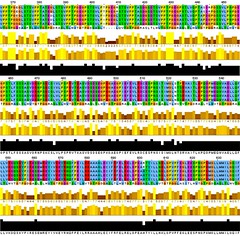 |
| Figure 3 (Photo credit: Libertas Academica) |
Paul is from Cal State LA. He was hired as "Biology Educator" - he focuses on education. They are focusing on GE Biology - they have a plant and animal bio. They have also converted to the semester system. They are planning on combing plant and animal into a single course. The course is an experiment. They will have data by the end of the year.
Problem
GE Biology is faciltiy and labor intensive with a steady drop in their student success rates.
They are replacing wet labs with online simulations. Thoughtfully implement online labs:
- Engaging students in scientific methodology
- Reducing demand for lab facilities
- Decreasing costs
- Addressing both facility and pedagogical bottlenecks
Project Plan
Overview
- Redesign GE Biology courses - conversion to semesters
- Two new modes of lab instruction vs. trad
- All labs offered online
- Two tracks online and wet labs alternating every week
- Both modes = :-) to :-) (Lecture and drop-in times)
- Labs are staffed with advanced students
- Engaging inquiry based exercises vs. traditional "cook book" labs
- Grading rubric for each online lab
Project Activities
BIOL 144" Animal Biology (future blend with plant)
Retain large lecture
Labs
- Fall 2013 (two large lecture sections and 16 all onlkne lab sections with 24 students in each lag with 6 GAs @ 10 hrs a week)
- Winter 2014 - One lecture secion and 8 traditional "wet" labs = 24 students /lab with instructor
- Spring 2014 - Two large lecture sections and 16 hybrid lab sections = 24 students /lab simulation results are idealized; lack of reality
- Five of the weekly labs offered online - others wet labs
- Eight of the 16 sections will start with wet labs and then alternate
- Three GAs will be hired at 10 hrs a week
Lab Handouts
- Distributed via Moodle
- Background information
- Detailed assignment instructions
- Assignment requires experiment and interpretation the results in a quiz
- Students create a report and turn it in to Moodle
- Reports are graded via a detailed rubric
Project Resources
They are using an online website both "Biology Labs On-Line" and "SmartScience Labs."
Projects Assessment
Ji Son, PhD is the project evaluator
Implementing survey tools
Several questions are being addressed including student satisfaction and performance.
- Which delivery mode to students prefer?
- Which model provides the best understanding of science?
- What problems to students encounter most?
- What could be improved?
- Do online labs lead to better grades?
There was a discussion about training GAs (graduate assistants).
Potential for Reducing Bottlenecks
- GE requirement
- Courses are limited by space and personnel costs
- Each lab section has 20-25 students and requires an instructor
- Offering labs for evening students is an additional challenge
- Online labs allow increase in enrollments
- Less need for lab facilities
- Less personnel needed
- Costs of personnel and facilites can be lowered by 44% by using virtual labs
Pedagogical Bottlenecks
- These courses are challenges for non-majors who often view science as a static body of facts
- Cookbook labs with no engagement
- Online labs allow students to design their own experiments
- Students enjoy the online labs
- Results in better student engagement
Scalability and Sustainability
All projects available via STEM Labs and MERLOT
We participated in a demonstration of "Biology Labs Online" http://BiologyLabsOnLine.com
We have used this model before with Health Information Management - we used online simulations to provide students with more opportunities to practice procedures.

No comments:
Post a Comment